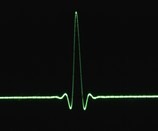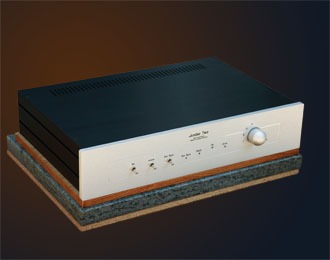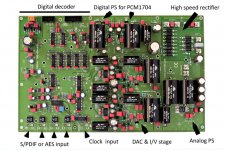After three years, many prototypes and intensive listening test, I present the Jundac Two, a high-end 24bit non-oversampling digital to analog converter. It integrates four inputs: S/PDIF or AES/EBU, an optional external clock for very low jitter operation and stereo fixed analog output.
A non oversampling DAC don't use any digital filter. Data coming from CD are directly converted to analog; there is no coloratura introduced by digital filtering, noise shaping or dithering. Before output, the signal is smoothed by a sweet first order low pass filter. To reach best listening quality, it can be coupled to an external low jitter clock.
High speed ICs are of the 74AC family with symmetrical output impedance and balanced propagation delay. To minimize reflection, all digital lines are loaded and PCB is 75ohm compliant. To minimize noise in power supply, critical capacitors are Wima FKP2 polypropylene film and foil. Analog section uses SCR polypropylene capacitors and Elna Silmic II electrolytic capacitor.
Power supplies in a DAC are critical to the overall design. The Jundac Two uses thirteen very low noise separate regulators. These power supplies use polypropylene capacitors and three separated power transformers.
Never a kit pushes so far music refinement. Learn more...
FEATURES
• FOUR DIGITAL INPUTS S/PDIF, AES3,
• DIGITAL TRANSFORMER INPUT,
• RCA, BNC or XLR input connector,
• ACCEPT 16, 18, 20, 24 BIT,
• 32K TO 192KHz,
• NO OVERSAMPLING, no digital filter,
• OPTIONAL CLOCK INPUT: 128FS to minimize jitter,
• INCLUDE CS8416 DIR RECEIVER with digital de-emphasis,
• DAC chips PCM1704
• LOW NOISE REGULATORS, LT1763, LT3080,
• BOARD SIZE: 305mm X 191mm
You can find a complete technical description on my web site and more pictures about this kit.
Hope you share this experience with us.
A non oversampling DAC don't use any digital filter. Data coming from CD are directly converted to analog; there is no coloratura introduced by digital filtering, noise shaping or dithering. Before output, the signal is smoothed by a sweet first order low pass filter. To reach best listening quality, it can be coupled to an external low jitter clock.
High speed ICs are of the 74AC family with symmetrical output impedance and balanced propagation delay. To minimize reflection, all digital lines are loaded and PCB is 75ohm compliant. To minimize noise in power supply, critical capacitors are Wima FKP2 polypropylene film and foil. Analog section uses SCR polypropylene capacitors and Elna Silmic II electrolytic capacitor.
Power supplies in a DAC are critical to the overall design. The Jundac Two uses thirteen very low noise separate regulators. These power supplies use polypropylene capacitors and three separated power transformers.
Never a kit pushes so far music refinement. Learn more...
FEATURES
• FOUR DIGITAL INPUTS S/PDIF, AES3,
• DIGITAL TRANSFORMER INPUT,
• RCA, BNC or XLR input connector,
• ACCEPT 16, 18, 20, 24 BIT,
• 32K TO 192KHz,
• NO OVERSAMPLING, no digital filter,
• OPTIONAL CLOCK INPUT: 128FS to minimize jitter,
• INCLUDE CS8416 DIR RECEIVER with digital de-emphasis,
• DAC chips PCM1704
• LOW NOISE REGULATORS, LT1763, LT3080,
• BOARD SIZE: 305mm X 191mm
You can find a complete technical description on my web site and more pictures about this kit.
Hope you share this experience with us.
Attachments
Brief history
The Jundac One and Two were made to demonstrate that non-oversampling (NOS) DAC can be a high-end DAC.
I start this project three years ago. The original idea of NOS DAC comes from Ryohei Kusunoki, in his article "Non-oversampling Digital filter-less DAC Concept" he explain the artifact introduced by digital filter.
At the beginning of this project, the first step was to isolate digital filter's signature. I use various kind of material. The most interesting of them was the WADIA 1000, X64. WADIA were probably the first in 1990 to understand that digital filter have sound signature. The Wadia 1000 is not a NOS DAC, it works at 64x ovsl while actual DAC upsample at 8x. In digital filter, the most important parameter is not the upsample rate; algorithm and numbers of TAP filters used by this algorithm are more important. The number of TAP indicates how many samples are necessary to compute one upsampled point. Using many TAPs results in important level of coloratura. Wadia's algorith use few TAPs.

Wadia's Dirac impulse response
Reduced algorithm is included in many manufactured DAC chip. It is the "Slow Roll Off" function. Today, others manufacturers are working on others advanced and reduced digital filters.
For a discussion on digital filter, see listening digital filter
It was very interesting to listen to Wadia and understand how a digital filter is not a transparent stage. That good listening experience confirm me that NOS DAC could sound good.
Jundac Two
In high-end product, everything is important: output stage, DAC, power supply, mechanical...
The digital filter is one of these points. A DAC is not good or bad only because it doesn't use or use any digital filter. Don't image that all NOS DAC have same sound!
The Jundac Two KIT includes assembled and tested PCB. It is also available assembled in aluminum chassis box, with 5 years warranty.
The Jundac Two offers high level of quality. When compared to manufactured audio references, the Jundac Two have an interesting position.

The Jundac One and Two were made to demonstrate that non-oversampling (NOS) DAC can be a high-end DAC.
I start this project three years ago. The original idea of NOS DAC comes from Ryohei Kusunoki, in his article "Non-oversampling Digital filter-less DAC Concept" he explain the artifact introduced by digital filter.
At the beginning of this project, the first step was to isolate digital filter's signature. I use various kind of material. The most interesting of them was the WADIA 1000, X64. WADIA were probably the first in 1990 to understand that digital filter have sound signature. The Wadia 1000 is not a NOS DAC, it works at 64x ovsl while actual DAC upsample at 8x. In digital filter, the most important parameter is not the upsample rate; algorithm and numbers of TAP filters used by this algorithm are more important. The number of TAP indicates how many samples are necessary to compute one upsampled point. Using many TAPs results in important level of coloratura. Wadia's algorith use few TAPs.

Wadia's Dirac impulse response
Reduced algorithm is included in many manufactured DAC chip. It is the "Slow Roll Off" function. Today, others manufacturers are working on others advanced and reduced digital filters.
For a discussion on digital filter, see listening digital filter
It was very interesting to listen to Wadia and understand how a digital filter is not a transparent stage. That good listening experience confirm me that NOS DAC could sound good.
Jundac Two
In high-end product, everything is important: output stage, DAC, power supply, mechanical...
The digital filter is one of these points. A DAC is not good or bad only because it doesn't use or use any digital filter. Don't image that all NOS DAC have same sound!
The Jundac Two KIT includes assembled and tested PCB. It is also available assembled in aluminum chassis box, with 5 years warranty.
The Jundac Two offers high level of quality. When compared to manufactured audio references, the Jundac Two have an interesting position.

Member
Joined 2009
Paid Member
It looks very nice, you've clearly done a lot of work. I don't think I've seen so many hi-end caps on the same pcb before !
Curious why you elected not to include low jitter clock on board. I know very little about DACs but I see people talking of the benefits of re-clocking. Do you think it would be a worthwhile upgrade to take advantage of the hooks you built in to this new DAC by adding a low jitter clock ?
Curious why you elected not to include low jitter clock on board. I know very little about DACs but I see people talking of the benefits of re-clocking. Do you think it would be a worthwhile upgrade to take advantage of the hooks you built in to this new DAC by adding a low jitter clock ?
Hi Bigun, thanks for your comments.
a) A clock is a noisy environment for a DAC and DAC is a noisy environment for a clock.
b) You can use various clock, build your own...
c) You can go to the ultimate configuration by using a single clock for all digital equipments. Slave your CD transport or sound card and put the clock as close as possible from DAC.
The Jundac Two includes a clock input. Here are some reasons to use external clock.It looks very nice; you've clearly done a lot of work. I don't think I've seen so many hi-end caps on the same pcb before!
Curious why you elected not to include low jitter clock on board. I know very little about DACs but I see people talking of the benefits of re-clocking. Do you think it would be a worthwhile upgrade to take advantage of the hooks you built in to this new DAC by adding a low jitter clock?
a) A clock is a noisy environment for a DAC and DAC is a noisy environment for a clock.
b) You can use various clock, build your own...
c) You can go to the ultimate configuration by using a single clock for all digital equipments. Slave your CD transport or sound card and put the clock as close as possible from DAC.
Member
Joined 2009
Paid Member
This is a very interesting solution.
Who have heard this NOS DAC against a version with digital filter in front of the PCM1704 (DF1704, PMD100 or PMD200)?
Who have heard this NOS DAC against a version with digital filter in front of the PCM1704 (DF1704, PMD100 or PMD200)?
- Status
- Not open for further replies.
- Home
- More Vendors...
- Junilabs
- Jundac Two, High-End NOS DAC Kit with PCM1704 up to 24bit/192KHz

